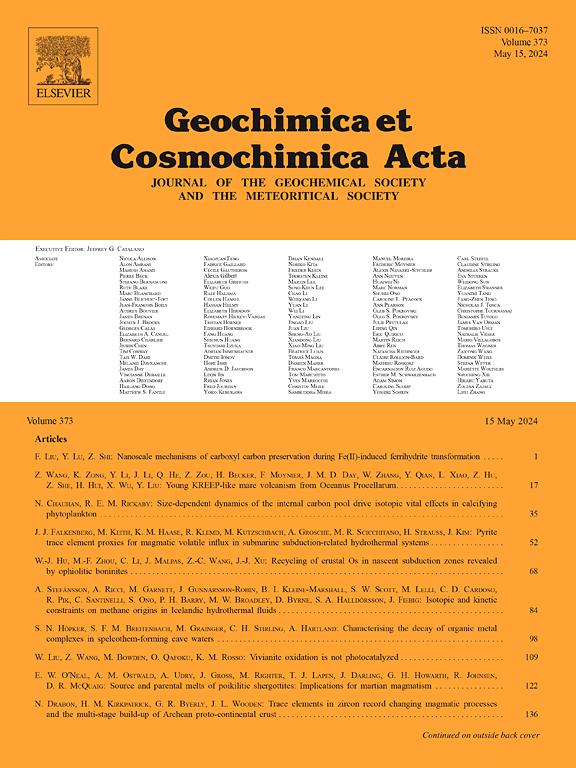Zirconium isotope considerations of carbonatite genesis and implications for carbonatite metasomatism of the Earth’s mantle
IF 5
1区 地球科学
Q1 GEOCHEMISTRY & GEOPHYSICS
引用次数: 0
Abstract
We present the first comprehensive survey of stable zirconium (Zr) isotope systematics in carbonatites of various ages from distinctive tectonic settings and with different mineralogy, chemistry, and the presence or absence of significant post-emplacement overprint. All these parameters are plausibly linked with extreme variability in abundances of Zr in carbonatites spanning over five orders of magnitude although Zr typically is considered as an immobile element. No temporal variation in δ94/90Zr values (per mil deviation from IPGP-Zr reference solution) is observed, indicating a global scale homogeneity of Zr isotope composition of the ultimate mantle sources of carbonatites over time, in accord with homogeneous δ94/90Zr (per mil deviation from IPGP-Zr solution) value of mantle and crust. Carbonatites devoid of significant post-magmatic mineral assemblages (hydrothermal baryte, goethite, chalcedony and fluorite) define a δ94/90Zr of +0.31 ± 0.08 ‰, which is ∼0.3 ‰ above the currently accepted mantle value. This difference likely is owing to Zr isotope fractionation during low-degree partial melting at mantle conditions and fractionation of carbonatite melts, although exact isotope fractionation factors between carbonate melt and silicate mantle have not yet been experimentally constrained, and alternative scenarios (diffusion, liquid immiscibility, different coordination of Zr in carbonate and silicate melts) should also be considered. This value also is ∼0.2 ‰ above mean crustal δ94/90Zr value and contamination by common crustal materials can thus be considered negligible. Most of the δ94/90Zr variation, in total reaching ∼0.5 ‰, is restricted to carbonatites with clear evidence of post-emplacement processes, resulting in 94Zr-depleted signature with δ94/90Zr as low as −0.10 ‰. This decrease is paralleled by broadly colinear increases in Zr/Hf and Nb/Ta. These observations collectively underscore the enhanced mobility of expectedly immobile Zr and Nb during overprint by F- and OH-rich liquids, paralleled by notable Zr isotope fractionation. Mantle lithologies metasomatized by carbonate-rich liquids may thus potentially acquire a wide range of Zr/Hf and Nb/Ta ratios, and δ94/90Zr values.
碳酸盐岩成因的锆同位素考虑及其对地幔碳酸盐岩交代作用的启示
本文首次全面调查了不同年龄的碳酸盐岩中稳定锆(Zr)同位素系统,这些碳酸盐岩来自不同的构造背景,具有不同的矿物学、化学特征,以及有无明显的侵位后叠印。所有这些参数似乎都与碳酸盐中Zr丰度的极端变化有关,这些变化跨越了五个数量级,尽管Zr通常被认为是一个不动的元素。δ94/90Zr值(与IPGP-Zr参考溶液的每mil偏差)没有时间变化,表明碳灰岩最终地幔源的Zr同位素组成在全球尺度上具有均匀性,与地幔和地壳的δ94/90Zr(与IPGP-Zr参考溶液的每mil偏差)一致。碳酸盐岩缺乏显著的岩浆后矿物组合(热液重晶石、针铁矿、玉髓和萤石),其δ94/90Zr为+0.31±0.08‰,比目前公认的地幔值高~ 0.3‰。这种差异可能是由于在地幔条件下低程度部分熔融和碳酸盐岩熔体的分馏,尽管碳酸盐熔体和硅酸盐地幔之间的确切同位素分馏因素尚未得到实验约束,并且还应考虑其他情况(扩散,液体不混溶,碳酸盐和硅酸盐熔体中Zr的不同配位)。该值也比地壳平均δ94/90Zr值高~ 0.2‰,因此普通地壳物质的污染可以忽略不计。δ94/90Zr的变化主要局限于具有明显侵位后作用证据的碳酸盐岩,δ94/90Zr低至- 0.10‰,δ94/90Zr的亏缺特征最大可达~ 0.5‰。这种下降与Zr/Hf和Nb/Ta的大致共线性增加相平行。这些观测结果共同强调,在富F和富oh的液体叠印过程中,预期不动的Zr和Nb的迁移率增强,与显著的Zr同位素分馏相平行。富碳酸盐流体交代的地幔岩性可能获得较大范围的Zr/Hf、Nb/Ta比值和δ94/90Zr值。
本文章由计算机程序翻译,如有差异,请以英文原文为准。
求助全文
约1分钟内获得全文
求助全文
来源期刊

Geochimica et Cosmochimica Acta
地学-地球化学与地球物理
CiteScore
9.60
自引率
14.00%
发文量
437
审稿时长
6 months
期刊介绍:
Geochimica et Cosmochimica Acta publishes research papers in a wide range of subjects in terrestrial geochemistry, meteoritics, and planetary geochemistry. The scope of the journal includes:
1). Physical chemistry of gases, aqueous solutions, glasses, and crystalline solids
2). Igneous and metamorphic petrology
3). Chemical processes in the atmosphere, hydrosphere, biosphere, and lithosphere of the Earth
4). Organic geochemistry
5). Isotope geochemistry
6). Meteoritics and meteorite impacts
7). Lunar science; and
8). Planetary geochemistry.
 求助内容:
求助内容: 应助结果提醒方式:
应助结果提醒方式:


